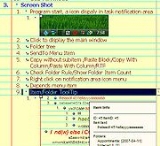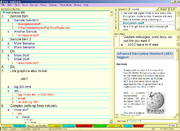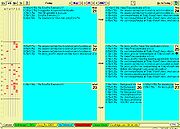
Ecco Pro
Encyclopedia
Ecco Pro is personal information manager
software based on an outliner, and supporting folders similar to spreadsheet columns that allow filtering and sorting of information based upon user defined criteria.
The software
was originally produced by Arabesque Software in 1993, then purchased by NetManage
, and discontinued in 1997.
structure and the ability to easily manipulate information
regardless of which view it was entered. Multiple notepad, calendar, and phonebook views can be opened, and each item seen in each view can be a collapsible outline, with each line assignable to folders/categories which can themselves be their own views, text field, pulldown menu, calendar date (including repeating date), or phonebook entry.

 ECCO Professional was introduced by Arabesque Software in 1993, as a Personal Information Manager
ECCO Professional was introduced by Arabesque Software in 1993, as a Personal Information Manager
(PIM) with a database backend. This version supports calendar and contact data, as well as to-do lists, and allows integration with other software via import and export capability, Dynamic Data Exchange
(DDE), Object Linking and Embedding
(OLE). A feature called "Shooter" puts a cut and paste tool at the top of the screen facilitating copy of data to and from ECCO. The user interface is based on a "universal outliner" and folders, which allow the user to build a variety of views organizing related information of mixed types. Data is stored as discrete objects, and can be dragged as dynamic links to multiple folders creating cross references. Ecco version 1.x supports shared folders and outlines for network access to data, but does not support windows workgroups. Ram based, the program was considered fast and relatively easy on laptop batteries, but a heavy consumer of system resources.
ECCO version 2.0, released in 1994, added support for workgroups, including group scheduling via email systems compliant with MAPI
or VIM
protocols, and Microsoft Schedule Plus
, and sharing of contacts, calendars, and outlines, as well as file synchronization and reconciliation via intranet
connections or email. In 1995 PC Magazine praised ECCO as a workgroup tool for scheduling and task management and noted its ability to handle free form data, but considered version 2.0 a "poor choice as a contact manager" which requires customization to match features of contemporary products, and lacks structured and complex search queries, good reporting, logging and correspondence functions.
ECCO version 3.0 was released in the summer of 1995 with an updated user interface based on a ring binder. Other additions include an Internet launch tool equipped with an address book containing links to over 2,000 sites. Internet support for the Shooter tool allows the user to push a url and title for a web page back to ECCO. Searching improved with a query tool based on forms and support for boolean filters.
ECCO Pro version 4.0 added 32 bit support and OLE 2.0. as well as integration with NetManage's Chameleon and Z-Mail. Version 4.01 has support for Palm Pilot.
and Bob Perez, a Harvard-trained lawyer hired by Apple as a programmer and Evangelist
in the 1980s. It was first released in 1993 by Arabesque Software, Inc., based in Bellevue, Washington
. PC Magazine
awarded ECCO Pro their Editor’s Choice award in 1996 and 1997
Development by NetManage
ceased in 1997 after the July 1997 release of version 4.01. Andrew Brown wrote in The Guardian
:
"So what happened to the paragon of a program? The market killed it. First it was sold to a much larger company, Netmanage; presumably doing this made the original programmers a lot of money. Then Netmanage panicked when Microsoft Outlook came along as a "free" part of the Office suite, and killed development on the program." NetManage chief executive officer Zvi Alon noted that 'As soon as Microsoft decided to give away Outlook with Office, we started getting phone calls questioning the value of Ecco Pro'.
Even though the source code for Ecco Pro is not open source, development of plugin extensions to the software continues. According to Scott Rosenberg, a programmer using the handle "slangmgh" developed an extension to Ecco Pro posted to ecco_pro users group on Yahoo which includes fixes and upgrades to the program, and may incorporate the Lua scripting language.
Personal information manager
A personal information manager is a type of application software that functions as a personal organizer. The acronym PIM is now, more commonly, used in reference to Personal information management as a field of study...
software based on an outliner, and supporting folders similar to spreadsheet columns that allow filtering and sorting of information based upon user defined criteria.
The software
Application software
Application software, also known as an application or an "app", is computer software designed to help the user to perform specific tasks. Examples include enterprise software, accounting software, office suites, graphics software and media players. Many application programs deal principally with...
was originally produced by Arabesque Software in 1993, then purchased by NetManage
NetManage
NetManage Inc. was a software company based in Cupertino, California, founded in 1990 by Zvi Alon, an Israeli engineer . The company’s development centre was located at the MATAM technology park, in Haifa, Israel...
, and discontinued in 1997.
Overview
The product offers three primary types of views — phone book views, calendar views, and notepad views. Central to the program's design is an outliningOutline
An outline is a list of the main features of a given topic, often used as a rough draft or summary of the content of a document. A hierarchical outline is a list arranged to show hierarchical relationships, and is a type of tree structure....
structure and the ability to easily manipulate information
Information
Information in its most restricted technical sense is a message or collection of messages that consists of an ordered sequence of symbols, or it is the meaning that can be interpreted from such a message or collection of messages. Information can be recorded or transmitted. It can be recorded as...
regardless of which view it was entered. Multiple notepad, calendar, and phonebook views can be opened, and each item seen in each view can be a collapsible outline, with each line assignable to folders/categories which can themselves be their own views, text field, pulldown menu, calendar date (including repeating date), or phonebook entry.
Product functionality


Personal information manager
A personal information manager is a type of application software that functions as a personal organizer. The acronym PIM is now, more commonly, used in reference to Personal information management as a field of study...
(PIM) with a database backend. This version supports calendar and contact data, as well as to-do lists, and allows integration with other software via import and export capability, Dynamic Data Exchange
Dynamic Data Exchange
Dynamic Data Exchange is a technology for interprocess communication under Microsoft Windows or OS/2.- Overview :Dynamic Data Exchange was first introduced in 1987 with the release of Windows 2.0 as a method of interprocess communication so that one program can communicate with or control another...
(DDE), Object Linking and Embedding
Object Linking and Embedding
Object Linking and Embedding is a technology developed by Microsoft that allows embedding and linking to documents and other objects. For developers, it brought OLE Control eXtension , a way to develop and use custom user interface elements...
(OLE). A feature called "Shooter" puts a cut and paste tool at the top of the screen facilitating copy of data to and from ECCO. The user interface is based on a "universal outliner" and folders, which allow the user to build a variety of views organizing related information of mixed types. Data is stored as discrete objects, and can be dragged as dynamic links to multiple folders creating cross references. Ecco version 1.x supports shared folders and outlines for network access to data, but does not support windows workgroups. Ram based, the program was considered fast and relatively easy on laptop batteries, but a heavy consumer of system resources.
ECCO version 2.0, released in 1994, added support for workgroups, including group scheduling via email systems compliant with MAPI
Messaging Application Programming Interface
Messaging Application Programming Interface is a messaging architecture and a Component Object Model based API for Microsoft Windows. MAPI allows client programmes to become messaging-enabled, -aware, or -based by calling MAPI subsystem routines that interface with certain messaging servers...
or VIM
Vendor Independent Messaging
VIM was a standard API for applications to integrate with e-mail on Windows 3.x, proposed by Lotus, Borland, IBM & Novell in the early 1990s. Its main competitor was Microsoft's MAPI, which was the eventual winner of the MAPI v. VIM war...
protocols, and Microsoft Schedule Plus
Microsoft Schedule Plus
Microsoft Schedule Plus was a time management software product developed by Microsoft, but was discontinued as part of Microsoft Office when most of its functionality was incorporated into Outlook 97...
, and sharing of contacts, calendars, and outlines, as well as file synchronization and reconciliation via intranet
Intranet
An intranet is a computer network that uses Internet Protocol technology to securely share any part of an organization's information or network operating system within that organization. The term is used in contrast to internet, a network between organizations, and instead refers to a network...
connections or email. In 1995 PC Magazine praised ECCO as a workgroup tool for scheduling and task management and noted its ability to handle free form data, but considered version 2.0 a "poor choice as a contact manager" which requires customization to match features of contemporary products, and lacks structured and complex search queries, good reporting, logging and correspondence functions.
ECCO version 3.0 was released in the summer of 1995 with an updated user interface based on a ring binder. Other additions include an Internet launch tool equipped with an address book containing links to over 2,000 sites. Internet support for the Shooter tool allows the user to push a url and title for a web page back to ECCO. Searching improved with a query tool based on forms and support for boolean filters.
ECCO Pro version 4.0 added 32 bit support and OLE 2.0. as well as integration with NetManage's Chameleon and Z-Mail. Version 4.01 has support for Palm Pilot.
History
Ecco Pro was originally developed by Pete Polash, who had sold an early Macintosh based presentation program to AldusAldus
Aldus Corporation, named after the 15th-century Venetian printer Aldus Manutius, was the inventor of the groundbreaking PageMaker software, a program that is generally credited with creating the desktop publishing field. The company was founded by Jeremy Jaech, Mark Sundstrom, Mike Templeman,...
and Bob Perez, a Harvard-trained lawyer hired by Apple as a programmer and Evangelist
Apple evangelist
An Apple evangelist, also known as Mac evangelist, Mac advocate or Apple fanboy is a promoter of Apple products such as the Macintosh, the iPod, the iPhone and the iPad. As a group, the followers are called the Cult of Mac....
in the 1980s. It was first released in 1993 by Arabesque Software, Inc., based in Bellevue, Washington
Bellevue, Washington
Bellevue is a city in the Eastside region of King County, Washington, United States, across Lake Washington from Seattle. Long known as a suburb or satellite city of Seattle, it is now categorized as an edge city or a boomburb. The population was 122,363 at the 2010 census.Downtown Bellevue is...
. PC Magazine
PC Magazine
PC Magazine is a computer magazine published by Ziff Davis Publishing Holdings Inc. A print edition was published from 1982 to January 2009...
awarded ECCO Pro their Editor’s Choice award in 1996 and 1997
Development by NetManage
NetManage
NetManage Inc. was a software company based in Cupertino, California, founded in 1990 by Zvi Alon, an Israeli engineer . The company’s development centre was located at the MATAM technology park, in Haifa, Israel...
ceased in 1997 after the July 1997 release of version 4.01. Andrew Brown wrote in The Guardian
The Guardian
The Guardian, formerly known as The Manchester Guardian , is a British national daily newspaper in the Berliner format...
:
"So what happened to the paragon of a program? The market killed it. First it was sold to a much larger company, Netmanage; presumably doing this made the original programmers a lot of money. Then Netmanage panicked when Microsoft Outlook came along as a "free" part of the Office suite, and killed development on the program." NetManage chief executive officer Zvi Alon noted that 'As soon as Microsoft decided to give away Outlook with Office, we started getting phone calls questioning the value of Ecco Pro'.
Even though the source code for Ecco Pro is not open source, development of plugin extensions to the software continues. According to Scott Rosenberg, a programmer using the handle "slangmgh" developed an extension to Ecco Pro posted to ecco_pro users group on Yahoo which includes fixes and upgrades to the program, and may incorporate the Lua scripting language.

